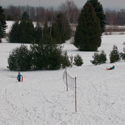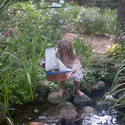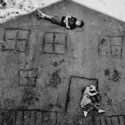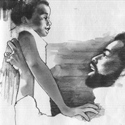I ordered the dog down and got on the phone to tell my wife to hurry out with the kids: there was a huge hawk in the park and it might not be there long. My daughter showed up a few seconds later and stood reverently by my side, eyes wide. I still expected it to fly away, thinking it was just there protecting some prey, but it didn't move. It occurred to me then it was badly injured, and we were scaring it. We stood still for a minute, snapping cell-phone cameras, and I realized this bird had now become my responsibility.
* * * * *
My son and I were killing time a few months ago, driving around a once-posh neighborhood on the east side when we came across a house and its yard covered in artfully-placed trash. We slowed to gawk at the clothing, stuffed animals, and riding toys slung across a huge fallen tree when an old man came rushing out of the house right up to the window of our car. He wore crocs, spandex leggings, and a hoodie. There were tubes or wires sprouting from a hole in his throat and he spoke to us with his hand against them. His lips moved but his voice came from somewhere else, amplified through an old-fangled artificial larynx. He said his name was Miko. He said something about how the bank was taking all his money. How he needed a lawyer. He wanted to know if I knew any lawyers. I could see the desperation in his eyes. Even the artificial larynx couldn't synthesize away his anguish. He told me I could have his house if only I could help him with his money. He kept spitting on the ground: long globules of clear drool. I knew we were in the presence of someone who was dying. My nerves were on edge. I sensed I wasn't completely safe. He was scaring my son. Still, I might have helped him. Instead I just handed him what was in my wallet and drove away.
* * * * *
I circled the hawk looking for any visible injuries. It Linda Blaired its neck to keep those yellow eyes on me. After a while I just stood there staring into those eyes, and I was probably imagining it but I was sure that bird was preparing to die. It had chosen the one place in the park where the grass was taller than everywhere else. This was its last stand hill. Its Alamo. The temperature was below freezing and the bird couldn't move. It was a very meditative moment. I remembered being a kid out in a forest after an ice storm and watching a huge tree crack under the weight of the ice and lean against another as it fell, taking almost an hour to get to the ground and nearly taking the other tree with it. I almost felt like I could have sat out there and watched that beautiful hawk die. I am no hero. I am not overly-sentimental about animals; I don't want to save every feral dog I find. I would hunt the pheasants. This wasn't just a house sparrow or even a little Cooper's hawk or some pigeon-eating falcon. I had seen this hawk drag away winter-fattened squirrels. In its shadow, neighbors feared for their Yorkies. If our positions were reversed, I have no doubt it would have torn my guts out and left the rest of me to steam on cold stalks of grass. I respect the raptors, aloof and freewheeling killers that they are. I could not let this one die. Not because I'm a good person (obviously). But because it was awesome.
I went home to get a cardboard box. I'd exchanged my wool coat for a thick leather jacket, and all I could think about were my thin gloves and Napoleon Dynamite's voice asking, "does it have sharp talons?" I didn't know how I planned to get the bird into the box; perhaps I imagined it would go willingly. I could only think of a few creatures on this planet that would go willingly into a box, and without the promise of cheese or a paycheck I doubted this hawk would. I tried to get in touch with my friend who catches and tags owls on the Puget Sound, but nobody was answering phones that night. A trusted neighbor I was able to reach came out and agreed the bird was too vulnerable on the ground and should be rescued.
I dropped the box over its head and tried to scoop it up; after a few tries it worked, and before I closed the cardboard flaps I saw the hawk lying on its back; either its talons could find no purchase or it was in such shock that it didn't even care about being comfortable. I have no experience with caring for birds but it turns out closing one inside a cardboard box is exactly what you're supposed to do when you find an injured raptor. I was worried it was hungry or thirsty so I cut translucent slivers of frozen chicken breast and defrosted them in warm water, offering them to the bird with chopsticks. It devoured them greedily while my kids watched in fascination from the other side of our screen door (it turns out feeding it was the wrong thing to do, as all the websites said not to feed an injured raptor anything).
Anyone who has "liked" this website's facebook page followed this saga all weekend; on Friday night I was able to turn to those hundreds of people and ask for advice about what to do and where I might take the hawk considering that all the animal rescue numbers were going straight to voicemail at that hour. I am so grateful for that help. I was able to get in touch with several helpful DNR-approved raptor rehabilitators. They advised me to bring the bird into the house and hide it away in a dark place, far from our unsuspecting birddog.
So we went to bed with a red-tailed hawk in our basement. I was sure it would be dead by morning, even if my kids had already given it a name: Snowflake Bonecracker.
* * * * *
The night after we met Miko I could hardly sleep. I told myself I would go back the next day without my son, maybe look at his paperwork and see if I could help. He'd asked me if I knew a lawyer and I hadn't been able to tell him that I had once been one, in some other life. That would have made me responsible for him, pulled me inextricably into his predicament. There are thousands of Mikos in Detroit. It occurred to me that all that garbage draped across his house wasn't just outsider art. It was his cry for attention. It was something he did so cars would slow down and maybe one of them would bring help. It was Crusoe's signal fire. The spinnerbait above the hook. Would I bring help? I told myself I would.
I never did.
* * * *
I had trouble sleeping the night we had a red-tailed hawk in our basement. I would wake up with visions of how we'd dispose of the body; a burial in the park, maybe. I wondered if I could resist the urge to keep a few of its feathers (a federal crime). My daughter woke at dawn full of questions about Snowflake. I wondered if its yellow eyes would be open in death or covered with the eerie blue membrane that stretched over them when they blinked. I prepared my daughter for any possibility and went to check.
As I approached the box on the shelf high above our washing machine, I heard a tiny flutter from inside. It might have echoed in my heart.
Inside the box, Snowflake Bonecracker was standing and alert. The hawk no longer looked like some dying thing. There was blood all over the shredded newspapers I'd placed in the box, and upon daylight inspection I saw dried blood all over the beak, with a green substance around the mouth. I thought this might be some sort of infection, but later learned that Snowflake Bonecracker was still a fledgling, probably born this year, and that fledglings always have green around their mouths and beaks. More importantly, I learned that morning that Snowflake Bonecracker was a she. It turned out her worst injury was a cracked beak.
I spent the morning texting with rehabilitators and e-mailing pictures. The first raptor rescue folks I spoke with were busy rescuing an eagle in western Michigan, but they put me in touch with a nearby facility willing to take the hawk.
Before I left I wanted to transfer her to a bigger box with a towel on the bottom so she'd be more comfortable on the 40-minute drive. I opened the box so the kids, my wife and mother-in-law could all quietly gather round to take one last look at this incredible creature.
She chose that moment to show us she could still fly.
After a moment of total panic, it was one of those things where everyone instinctively did what they had to do. The hawk was suddenly up in the air and everywhere at once. Pandemonium. Chaos. Tumult. The womenfolk dragged the kids out of the room away from the raptor's claws and erratic flight while I tried to contain it. The bird shot a 12-guage spray of white uric acid across the parquet, thinking she was going to head right through the floor-to-ceiling windows (following standard raptor procedure of taking a dump before they take to the air). She hit the glass once and tried again. The highest she got was the top of the Christmas tree, and after knocking down a few ornaments she fell to the floor to pace on front of the window, staring right into unachievable freedom. Crap, there's a large, angry red-tailed hawk on the loose in my house.
Better take a picture.
I called the raptor lady. "Um. . .she seems to be doing much better. She's loose and flying around my house. Should I open the door to let her out?" If I did, she said, the hawk would just end up back on the ground in shock, unable to eat. I had to pick her up before she caused any more damage.
Lifting that huge bird with my bare hands. . . drawing its wings in with my fingertips on its keel. . . seeing her turn to give me a look of stoic resignation: that was one of the coolest things I have ever done.
* * * * *
The diagnosis came an hour or so later. The beak would need a few months to heal; she wouldn't be able to feed herself until it did. There was also a fracture in one wrist. She probably crashed into a building. She would have died in the grass. Instead she'll spend the next few months with four other injured red-tailed hawks in a rehab aviary before being released back into the urban wild this spring.

































